A Stabilized Single-Longitudinal-Mode and Wide Wavelength Tunability Erbium Laser
Abstract
:1. Introduction
2. Experiment and Results
3. Conclusions
Author Contributions
Funding
Institutional Review Board Statement
Informed Consent Statement
Conflicts of Interest
References
- Wang, X.; Zhu, T.; Chen, L.; Bao, X. Tunable Fabry-Pérot filter using hollow-core photonic bandgap fiber and micro-fiber for a narrow-linewidth laser. Opt. Exp. 2011, 19, 9617–9625. [Google Scholar] [CrossRef] [PubMed]
- Wang, L.; Dong, X.; Shum, P.P.; Huang, C.; Su, H. Erbium-doped fiber laser with distributed Rayleigh output mirror. Laser Phys. 2014, 24, 115101. [Google Scholar] [CrossRef]
- Wang, Z.; Shang, J.; Mu, K.; Yu, S.; Qiao, Y. Stable single-longitudinal-mode fiber laser with ultra-narrow linewidth based on convex-shaped fiber ring and Sagnac loop. IEEE Access 2019, 7, 166398–166403. [Google Scholar] [CrossRef]
- Kuo, S.T.; Peng, P.C.; Kao, M.S.; Lu, H.H.; Chen, J.F. Tunable erbium-doped fiber ring laser with signal-averaging function for fiber-optic sensing applications. Laser Phys. 2011, 21, 188–190. [Google Scholar] [CrossRef]
- Cheng, X.P.; Shum, P.; Tse, C.H.; Zhou, J.L.; Tang, M.; Tan, W.C.; Wu, R.F.; Zhang, J. Single-longitudinal-mode erbium-doped fiber ring laser based on high finesse fiber Bragg grating Fabry-Pérot etalon. IEEE Photon. Technol. Lett. 2008, 20, 976–978. [Google Scholar] [CrossRef]
- Liu, X.; Yang, X.; Lu, F.; Ng, J.; Zhou, X.; Lu, C. Stable and uniform dual-wavelength erbium-doped fiber laser based on fiber Bragg gratings and photonic crystal fiber. Opt. Express 2005, 13, 142–147. [Google Scholar] [CrossRef] [PubMed]
- Yeh, C.-H.; Wang, B.-Y.; Hsu, W.-H.; You, W.-Y.; Chen, J.-R.; Chow, C.-W.; Chen, J.-H. Stable and selectable erbium multiple-ring laser with self-injection loop. Opt. Laser Technol. 2021, 141, 107106. [Google Scholar] [CrossRef]
- Saeung, P.; Yupapin, P.P. Vernier effect of multiple-ring resonator filters modeling by a graphical approach. Opt. Eng. 2007, 46, 075005. [Google Scholar] [CrossRef]
- Huang, L.; Yang, C.; Tan, T.; Lin, W.; Zhang, Z.; Zhou, K.; Zhao, Q.; Teng, X.; Xu, S.; Yang, Z. Sub-kHz-linewidth wavelength-tunable single-frequency ring-cavity fiber laser for C- and L-band operation. J. Lightw. Technol. 2021, 39, 4794–4799. [Google Scholar] [CrossRef]
- Yeh, C.-H.; Huang, T.-J.; Yang, Z.-Q.; Chow, C.-W.; Chen, J.-H. Stable single-longitudinal-mode erbium fiber ring laser utilizing self-injection and saturable absorber. IEEE Photon. J. 2017, 9, 7106206. [Google Scholar] [CrossRef]
- Zhu, T.; Zhang, B.; Shi, L.; Huang, S.; Deng, M.; Liu, J.; Li, X. Tunable dual-wavelength fiber laser with ultra-narrow linewidth based on Rayleigh backscattering. Opt. Express 2016, 24, 1324–1330. [Google Scholar] [CrossRef] [PubMed]
- Md Ali, M.I.; Ibrahim, S.A.; Abu Bakar, M.H.; Noor, A.S.M.; Ahmad Anas, S.B.; Zamzuri, A.K.; Mahd, M.A. Tapered-EDF-based Mach-Zehnder interferometer for dual-wavelength fiber laser. IEEE Photon. J. 2014, 6, 5501209. [Google Scholar] [CrossRef]
- Yeh, C.-H.; Zhuang, Y.-H.; Tsai, N.; Chow, C.-W.; Chen, J.-H. Use of proper cavity loss for stable single-longitudinal-mode erbium fiber laser. Laser Phys. 2017, 27, 065109. [Google Scholar] [CrossRef]
- Chen, X.; Xian, L.; Ogusu, K.; Li, H. Single-longitudinal-mode Brillouin fiber laser incorporating an unpumped erbium-doped fiber loop. Appl. Phys. B 2012, 107, 791–794. [Google Scholar] [CrossRef]
- Chen, H.; Babin, F.; Leblanc, M.; Schinn, G.W. Widely tunable single-frequency erbium-doped fiber lasers. IEEE Photon. Technol. Lett. 2003, 15, 185–187. [Google Scholar] [CrossRef]
- Yeh, C.H.; Chow, C.W. Broadband wavelength-tunable single-longitudinal-mode erbium-doped fiber ring laser using saturable-absorber filter. Laser Phys. Lett. 2010, 7, 158–163. [Google Scholar] [CrossRef]
- Wang, F.Z.; Shang, J.; Mu, K.; Qiao, Y.; Yu, S. Stable single-longitudinal-mode dual-ring fiber laser with ultra-narrow linewidth. In Proceedings of the CLEO, San Jose, CA, USA, 10–15 May 2020. STh3P.1. [Google Scholar]
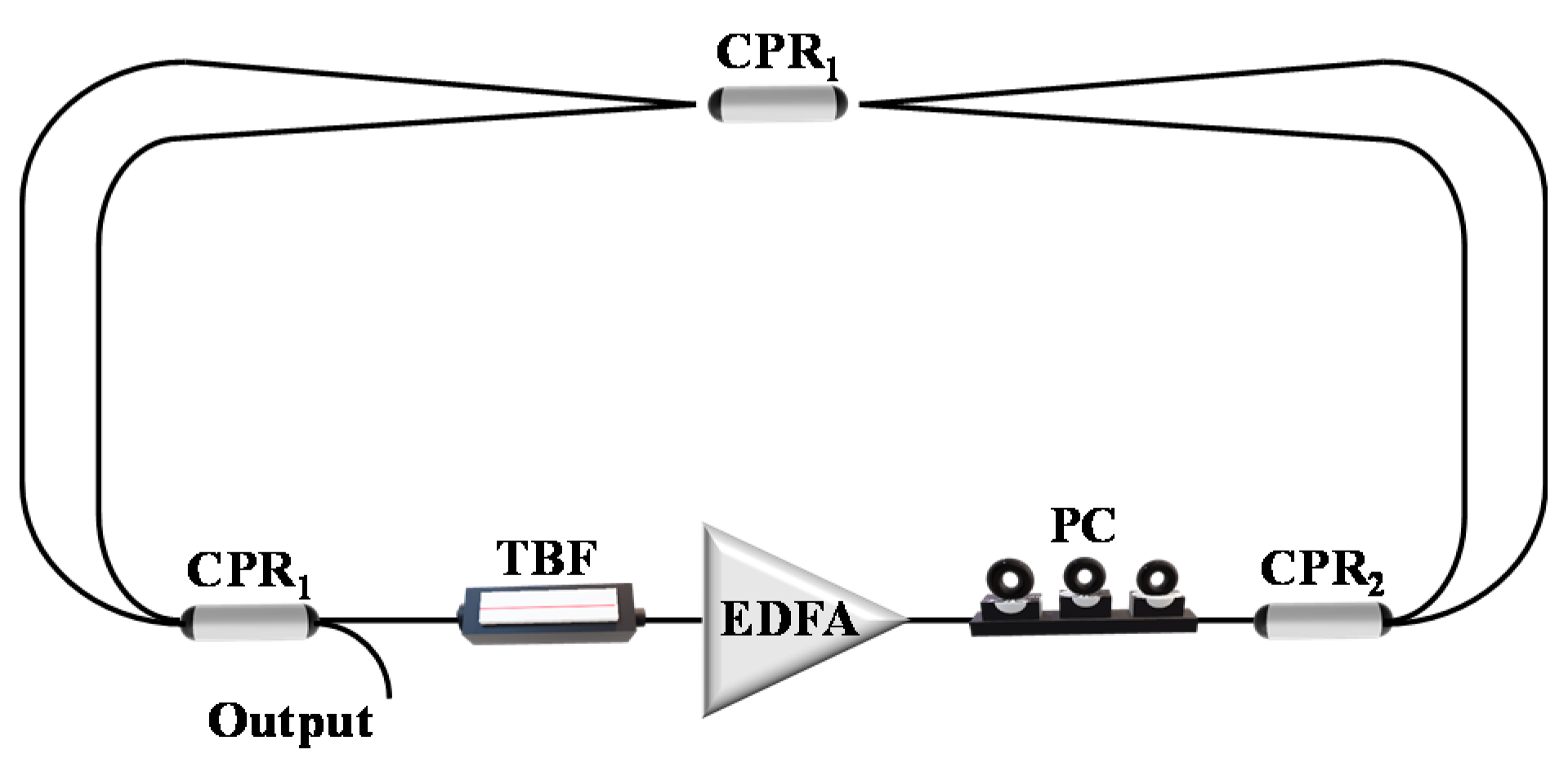

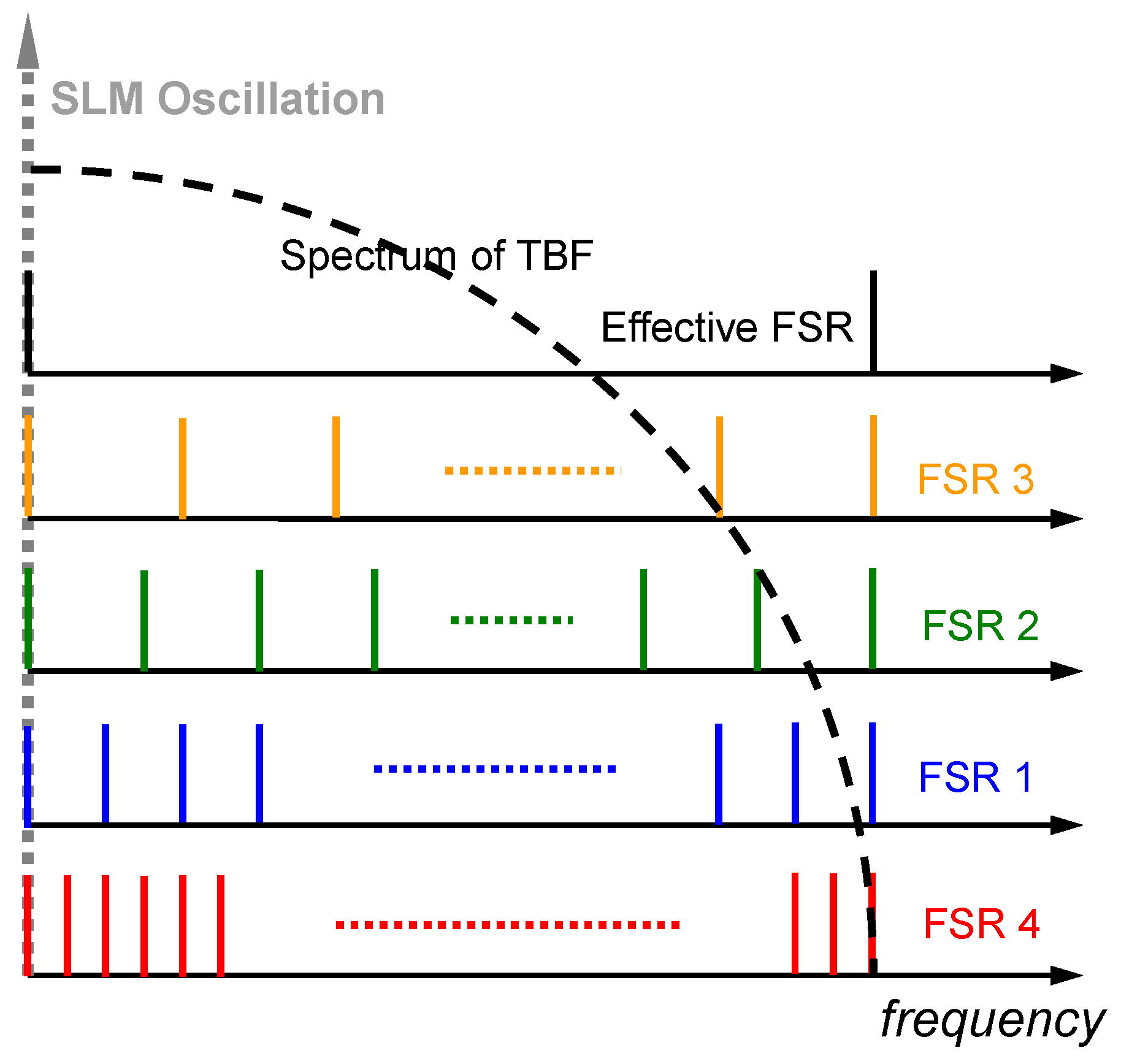

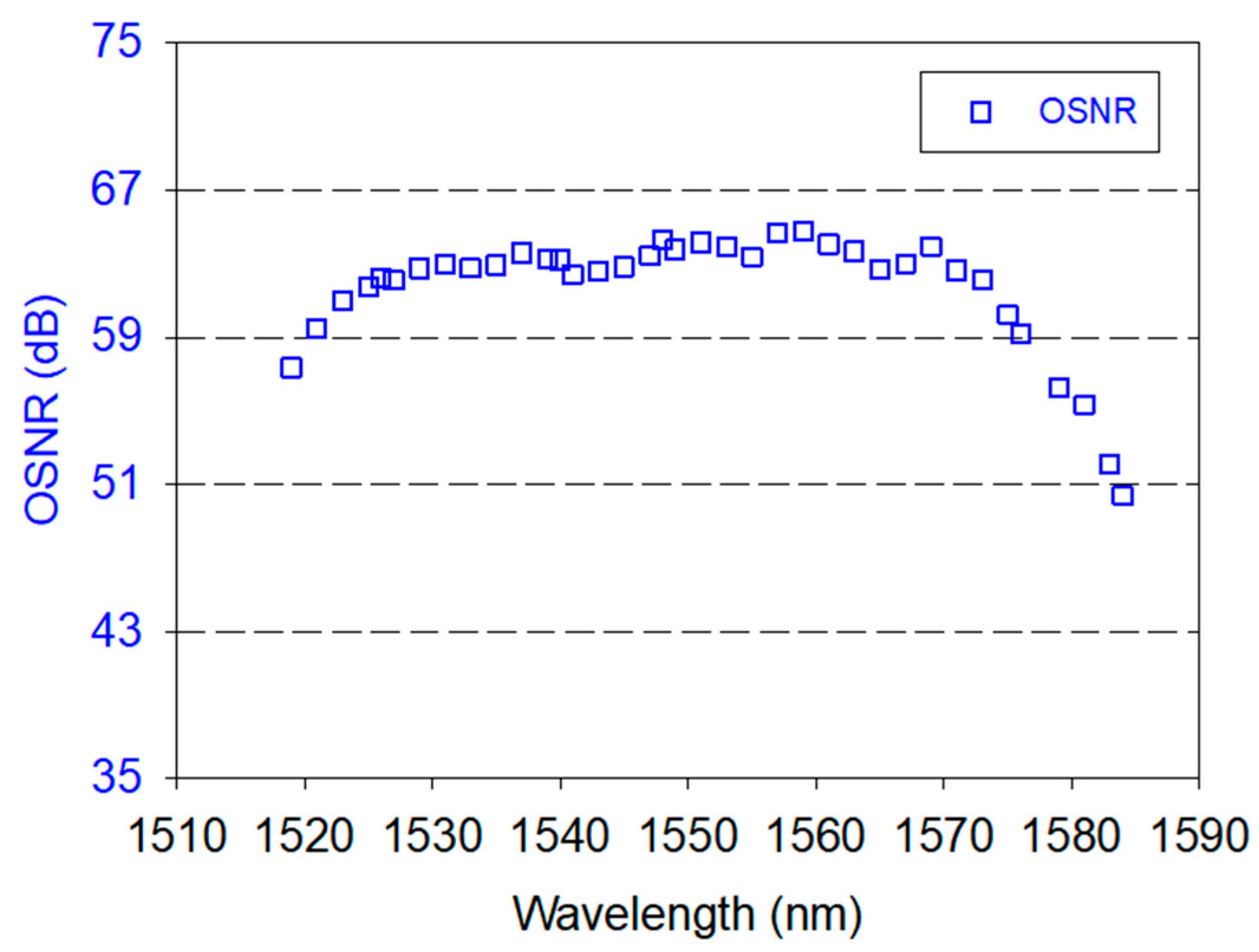

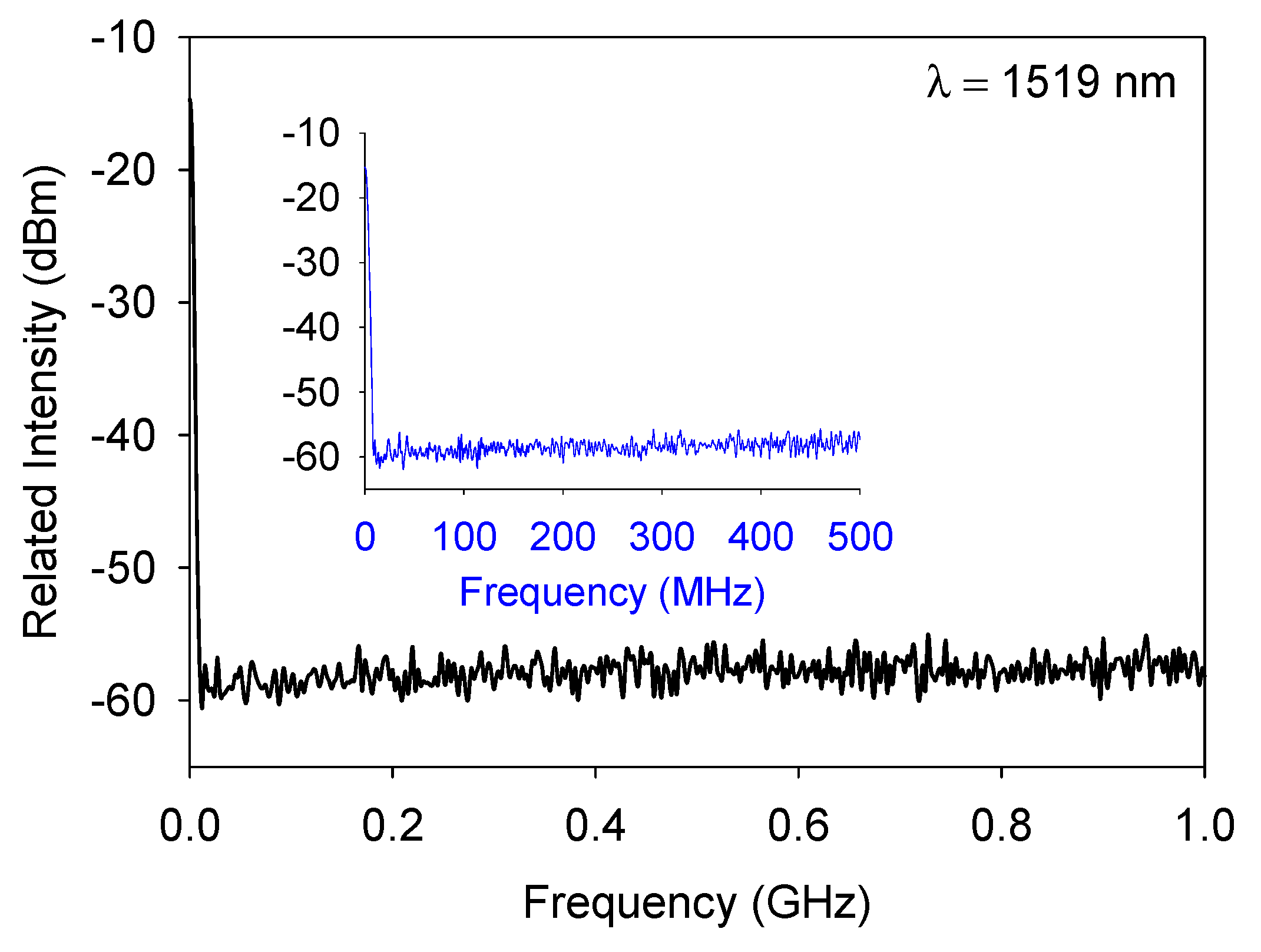
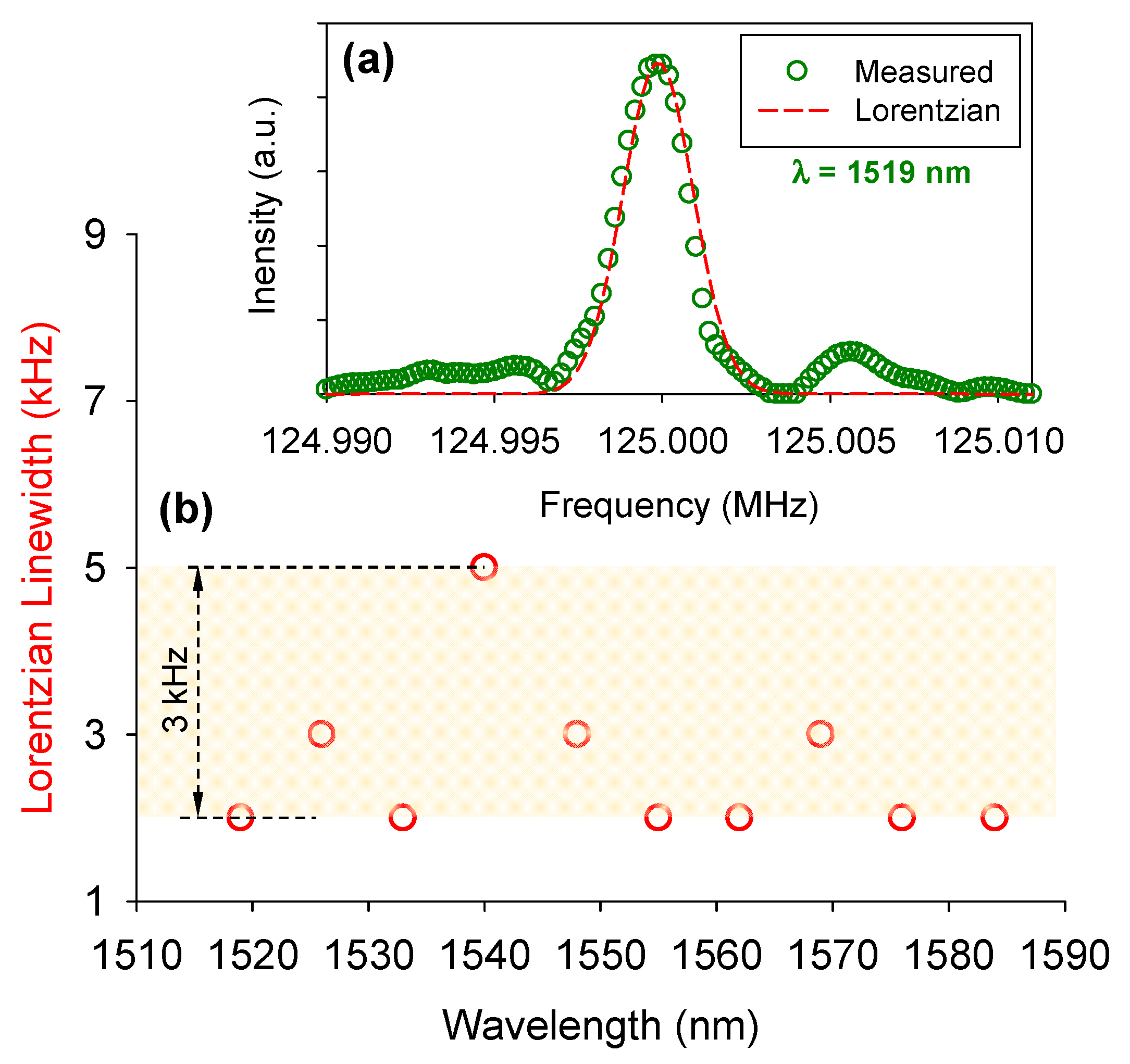
Publisher’s Note: MDPI stays neutral with regard to jurisdictional claims in published maps and institutional affiliations. |
© 2022 by the authors. Licensee MDPI, Basel, Switzerland. This article is an open access article distributed under the terms and conditions of the Creative Commons Attribution (CC BY) license (https://creativecommons.org/licenses/by/4.0/).
Share and Cite
Chen, L.-C.; Lai, Y.-T.; Yeh, C.-H.; Lin, W.-P.; Chow, C.-W.; Chen, J.-H. A Stabilized Single-Longitudinal-Mode and Wide Wavelength Tunability Erbium Laser. Photonics 2022, 9, 336. https://doi.org/10.3390/photonics9050336
Chen L-C, Lai Y-T, Yeh C-H, Lin W-P, Chow C-W, Chen J-H. A Stabilized Single-Longitudinal-Mode and Wide Wavelength Tunability Erbium Laser. Photonics. 2022; 9(5):336. https://doi.org/10.3390/photonics9050336
Chicago/Turabian StyleChen, Li-Ci, Yi-Ting Lai, Chien-Hung Yeh, Wen-Piao Lin, Chi-Wai Chow, and Jing-Heng Chen. 2022. "A Stabilized Single-Longitudinal-Mode and Wide Wavelength Tunability Erbium Laser" Photonics 9, no. 5: 336. https://doi.org/10.3390/photonics9050336
APA StyleChen, L.-C., Lai, Y.-T., Yeh, C.-H., Lin, W.-P., Chow, C.-W., & Chen, J.-H. (2022). A Stabilized Single-Longitudinal-Mode and Wide Wavelength Tunability Erbium Laser. Photonics, 9(5), 336. https://doi.org/10.3390/photonics9050336







